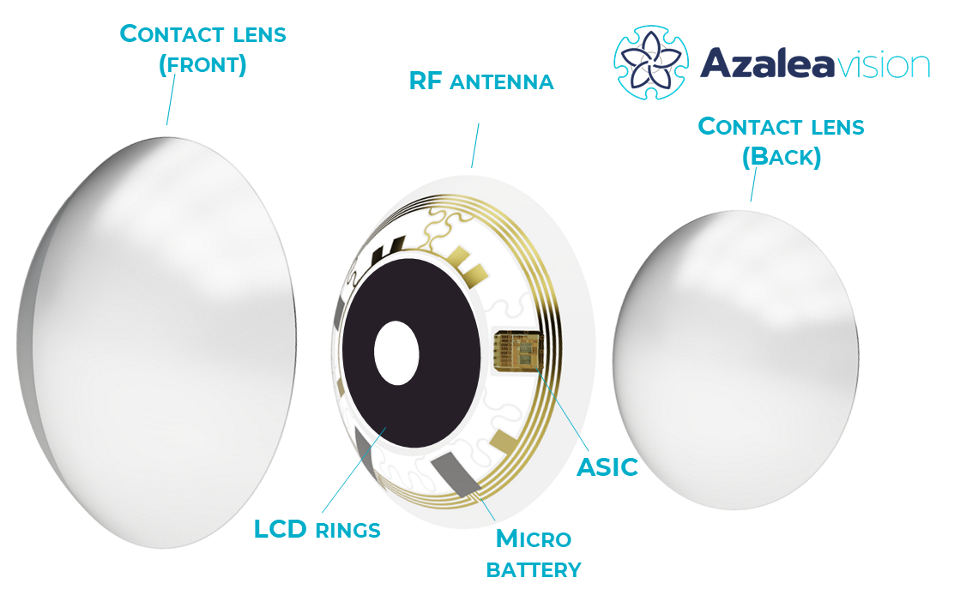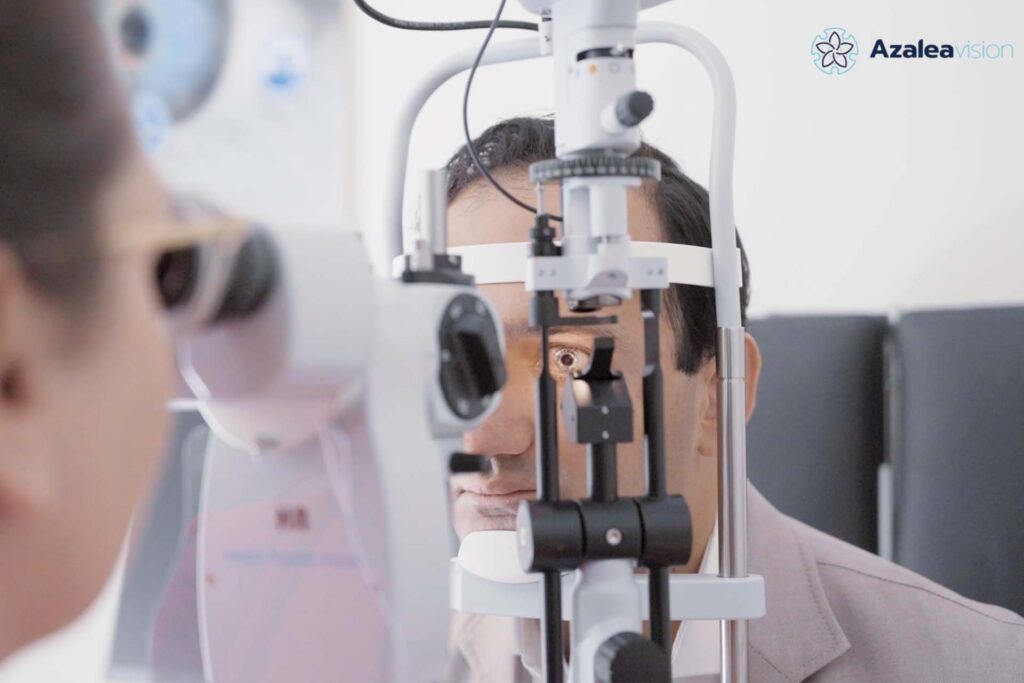A non-surgical solution
There are a number of eye disorders which lead to blurry or distorted vision due to an inability to correctly filter how much light enters the eye. For example, irregular astigmatism describes a group of disorders in which the eye cannot correctly refract light onto the retina. It can be caused by bulging of the cornea (the outer layer of the eye) or damage to the corneal surface, sometimes as a result of laser eye surgery. Though not a common category of disorders, it still affects nearly 6 million people worldwide with corneal surgery combined with contact lenses being the current standard of care. But in severe cases of irregular astigmatism, the solutions available today cannot improve vision up to 20/20.
Azalea Vision has developed a non-surgical solution for treating a variety of vision disorders, including irregular astigmatism. Their futuristic smart contact lens has been created with a tuneable diaphragm meant to mimic the human iris, the structure in the eye which controls pupil diameter.
Futuristic iris
Andrés Vásquez Quintero, co-founder and CTO of Azalea Vision, has a background in printed and micro-electronics. It was after joining imec/Ghent University as a postdoctoral researcher in 2016 when the idea of smart contact lenses was born. “How do you put advanced technology inside of a very small space? At the time, we were just following the trends of technology miniaturization: everything should be smaller, should consume less power, should be transparent and flexible, et cetera. But then, at the same time, it was very clear to us, and to me especially, that this could be used in medical applications.”
“The objective was always to try to make invisible electronics, not in the sense that you cannot see them, but that you cannot feel them. They adapt comfortably to the shape of your body.” – Andrés Vásquez Quintero, Co-founder and CTO of Azalea Vision
The decision to apply their technology to ocular disorders came from discussions with doctors at the University Hospital in Ghent. The focus was put on selection of disorders – irregular astigmatism, photophobia (light sensitivity) and early presbyopia (difficulty in seeing objects close-up) – that could be treated by changing the diameter of the pupil, filtering out some of the light entering the eye. With the right aperture adjusted to incoming light, images will be focused on the retina and blurry vision will disappear.
The first application of the ALMA smart lens will be used to treat keratoconus, a form of irregular astigmatism. Due to thinning, the cornea is deformed into a conical shape, which then distorts light coming into the eye, leading to blurry vision, glare, light halos and poor night vision. Co-founder and CEO Enrique Vega explains, “Because of this conical shape, the rays of light entering the retina are defocused. By providing these patients with our smart lens, we provide a functional iris which filters out aberrated light by closing the diaphragm. Only the focused light will enter the eye.”
Liquid crystals and their light filtering capabilities

Azalea Vision’s smart lens is a sophisticated piece of technology, containing a controller, a micro battery, and a radio frequency (RF) antenna to allow it to connect to an external device for adjustment. These intricate parts are all sandwiched between standard contact lens material and modify a liquid crystal ring in the center, which acts as the functional iris for the wearer.
“The main electro-optic component is based on liquid crystals, the same type of material used on computer screens and smartphones,” Vásquez Quintero explains. “The way liquid crystal works is when we apply a voltage, these molecules turn. We mix these liquid crystals with a dye, which will then rotate along with the liquid crystal molecules. By turning them, we can change their transparency. When they are in a vertical alignment, they don’t absorb much light and look transparent. But when they become horizontal, they absorb more light, and then they look dark. In this way we create a non-mechanical diaphragm that controls the light entering the eye.”
User-friendly operation
So, how can the smart lens be personalized for a specific patient’s need? The embedded microchip in the ALMA smart lens contains a sensor which can measure the amount of light entering the eye. In coordination with an ophthalmologist or optician, the best functional diameters of the liquid crystal rings can be identified for the patient and then be loaded into the lens by the Azalea team.
“Due to the built-in transmitter, the user can move a smart case towards the lens while in the eye to change the visual mode, so they don’t need to take it out, change its state, and put it back in.” – Enrique Vega, Co-founder and CEO of Azalea Vision
The lens settings are flexible. It could have a single fixed ring that the patient uses only when needed, or it could be tuned with multiple settings for different scenarios, such as one for bright outdoor light and one for low light, or for night driving. In the case of multiple diameter settings, the user can switch between these using a smart case, which can connect to a transmitter in the lens. Using the light sensors in the lens, it could also be self-modifying to respond automatically to various light levels.
Beyond clear vision
In addition to being used as a treatment for a variety of ocular disorders, the technology in the smart lens can also be harnessed for biomonitoring. The microchip in the lens could be equipped with biosensors which could be used to measure eye pressure (for glaucoma), glucose (for diabetes) or other biomarkers in the tear fluid which could be used to identify concerning health conditions.
Vega’s engineering and professional background included a focus on heart conditions, and he sees the potential for the smart lens to be used as a diagnostic tool in future cardiology applications. “Patients who experience heart failure need to go frequently to the hospital to measure different substances in the blood that you can also find in the tear fluid,” says Vega. “So why not think about a device, even if you don’t have an ophthalmology issue, that you can put in the eye for 30 minutes in the morning, put it back in your smart case, and send the information off for analysis. You avoid the need to go to the hospital for a simple test. We can deliver value for those patients.”
Clinical testing is still needed for Azalea Vision’s smart lens, but the future is looking crystal clear. As a versatile tool for personalized vision enhancement and cutting-edge biomonitoring, the smart lens may be ushering in a new era for eye care and health diagnostics.
For more ocular innovations, read this V-Bio article about Oxular’s unique drug delivery system for the eye


